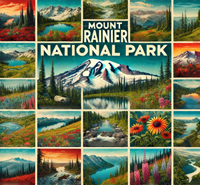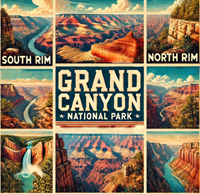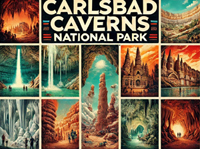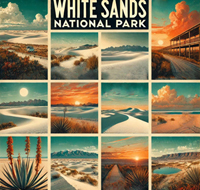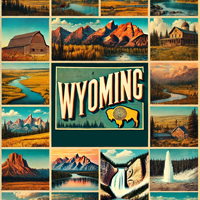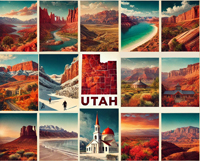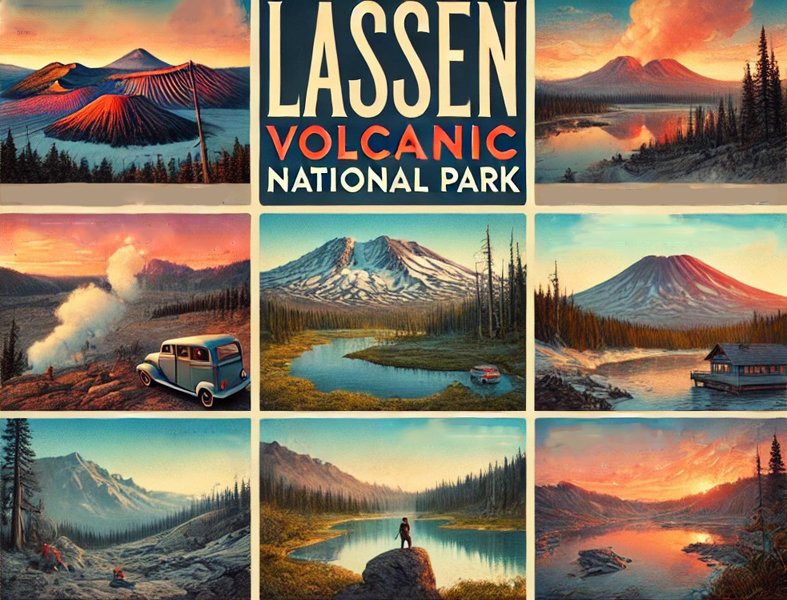

Embark on a journey curated by seasoned explorers William and Hui Cha Stanek, who have spent decades immersing themselves in the diverse landscapes of North America. These itineraries are more than just travel plans - they are thoughtfully crafted adventures designed to help you connect with the natural world, discover hidden gems, and create lasting memories.
National Parks Index | US Itineraries Index | American Roadtrips Index

Bring home a Bugville Critters book and watch as your child's love for reading and learning grows with every page. Hand-painted illustrations bring the heartwarming stories to life. Ask your librarian to add Bugville Critters to the library's digital collection today!
Discover William Stanek's Exclusive Art Collection
Explore and purchase the stunning art featured on this site. Own a piece of William Stanek's unique and captivating artwork today!
(June 7, 2025) A Day in The Fire and Water of Northern California: Lassen Volcanic National Park and Burney Falls
Introduction: A Journey Through Fire and Water
Personal Story: William's Encounter with California's Wild Landscapes
The first time I ventured into Lassen Volcanic National Park, I was immediately struck by the raw and untamed beauty of this volcanic landscape. The park is a geological wonder, filled with steaming fumaroles, bubbling mud pots, and towering peaks shaped by ancient eruptions. As I hiked through the park, I was constantly reminded of the powerful forces that have shaped our planet. I remember standing at the edge of Bumpass Hell, the park's largest hydrothermal area, watching the steam rise from the boiling springs and feeling the heat radiate from the ground beneath my feet. It was a humbling experience, a reminder of the earth's incredible power and the ever-changing nature of our world.
A short drive from Lassen Volcanic National Park took me to Burney Falls, a place that felt like the polar opposite of the volcanic landscape I had just explored. The falls, often described as one of the most beautiful waterfalls in California, cascade 129 feet down into a lush, moss-covered basin. The contrast between the fiery landscape of Lassen and the serene beauty of Burney Falls was striking. As I stood there, mesmerized by the sound of the rushing water and the vibrant greenery surrounding the falls, I felt a deep sense of peace and connection to nature. These two places, though so different, are a perfect pairing for an adventure that showcases the diverse beauty of Northern California's wild landscapes. In this guide, Hui Cha and I will share our experiences exploring Lassen Volcanic National Park and Burney Falls, along with our favorite hikes, photography spots, and insider tips to help you make the most of your visit.
About Lassen Volcanic National Park
Lassen Volcanic National Park, located in Northern California, is a unique and dynamic landscape shaped by the forces of fire and ice. The park is home to all four types of volcanoes – shield, composite, cinder cone, and plug dome – and is one of the few places in the world where you can see them all in a single park. The park's centerpiece is Lassen Peak, the largest plug dome volcano in the world, which last erupted in 1915. Today, the park is a haven for hikers, photographers, and nature lovers, offering a wide range of activities from exploring hydrothermal areas like Bumpass Hell to hiking through lush forests and alpine meadows. Whether you're scaling the heights of Lassen Peak, walking through a bubbling geothermal landscape, or simply soaking in the serene beauty of the park's lakes and forests, Lassen Volcanic National Park offers an unforgettable experience of California's wild and rugged beauty.
About Burney Falls
Burney Falls, located in McArthur-Burney Falls Memorial State Park, is one of the most beautiful and iconic waterfalls in California. The falls are fed by underground springs, which keep the water flowing year-round, even during the dry summer months. The water cascades 129 feet down into a turquoise pool surrounded by lush, moss-covered rocks and ferns. The falls are often described as the "Eighth Wonder of the World," and it's easy to see why. The sound of the rushing water, the cool mist rising from the falls, and the vibrant greenery surrounding the basin create a serene and magical atmosphere. Whether you're hiking the trails around the falls, picnicking by the river, or simply standing at the overlook, taking in the beauty of the falls, Burney Falls offers a peaceful and rejuvenating escape in the heart of Northern California.
Day 1: A Deep Dive into Lassen Volcanic National Park
Morning: Sunrise at Manzanita Lake
6:00 AM - Start at Manzanita Lake
Overview: Begin your adventure in Lassen Volcanic National Park with a sunrise at Manzanita Lake, one of the most picturesque spots in the park. The lake is known for its stunning reflections of Lassen Peak, especially in the early morning when the water is calm and the light is soft. This is a perfect spot to start your day, with the quiet beauty of the lake and the surrounding forest setting the tone for your exploration of the park.
Tips from William: "Sunrise at Manzanita Lake is a must-do for any photographer visiting Lassen. The reflections of Lassen Peak in the calm water create a perfect mirror image, especially when the light is soft and golden. Bring a wide-angle lens to capture the full scene, and a tripod for long exposures. The early morning light is ideal for landscape photography, with the warm colors and soft shadows adding depth to your photos."
Insights from Hui Cha: "The area around Manzanita Lake is peaceful and serene in the early morning, with only the sounds of birds and the occasional splash of a fish breaking the silence. After watching the sunrise, consider taking a short walk along the lake's edge to explore the area. The trail around the lake is easy and flat, making it accessible for all ages and fitness levels."
How to Access Manzanita Lake
Location: Manzanita Lake is located near the northwest entrance of Lassen Volcanic National Park, easily accessible from the main park road.
Directions: From the park entrance, follow the main road towards the Manzanita Lake area. The lake is well-marked, with parking available near the trailhead.
Exploration Details: Manzanita Lake is easily accessible from the parking area, with a flat and easy trail that loops around the lake. The best time to visit is at sunrise when the light is soft and the reflections are at their most dramatic.
Photography Techniques:
-
Lake Reflections: Use a wide-angle lens to capture the reflections of Lassen Peak in the calm waters of Manzanita Lake. A polarizing filter can help reduce glare and enhance the colors, while a tripod is essential for long-exposure photography.
-
Sunrise Colors: The soft, golden light of sunrise is perfect for landscape photography. Use a tripod to capture the subtle colors and patterns in the sky, and experiment with different compositions to create a sense of depth.
-
Close-Ups of Flora and Fauna: The area around Manzanita Lake is home to a variety of plants and animals, making it a great spot for close-up photography. Use a macro lens to capture the intricate details of the wildflowers, insects, and animal tracks along the trail.
Alternative Activity:
If you prefer a less crowded spot for sunrise, consider heading to Summit Lake instead. This smaller, more secluded lake offers equally stunning views of Lassen Peak and is a bit further from the main road, providing a quieter experience.
Mid-Morning: Hiking the Bumpass Hell Trail
9:00 AM - Hike the Bumpass Hell Trail
Overview: After your sunrise at Manzanita Lake, head to one of Lassen Volcanic National Park's most famous attractions – the Bumpass Hell Trail. This trail takes you to the park's largest hydrothermal area, where you can witness the park's volcanic activity up close. The trail is relatively easy, with a well-maintained path that leads to a boardwalk area where you can safely view the boiling springs, fumaroles, and mud pots.
Tips from William: "The Bumpass Hell Trail is a must-do hike in Lassen Volcanic National Park. The geothermal features are fascinating, and the boardwalk allows you to get up close without damaging the delicate environment. Bring a wide-angle lens to capture the sweeping views of the hydrothermal area, and a telephoto lens for close-ups of the bubbling springs and steam vents."
Insights from Hui Cha: "The trail to Bumpass Hell is about 3 miles round trip, with a moderate elevation gain of around 500 feet. The trail is well-marked and maintained, but the altitude and sulfurous smells can be challenging for some visitors. Be sure to bring plenty of water and take your time to enjoy the views. The boardwalk area offers great photo opportunities, so take your time to explore and capture the unique beauty of this geothermal landscape."
How to Access the Bumpass Hell Trail
Location: The Bumpass Hell Trailhead is located along the main park road, about 6 miles from the southwest entrance of Lassen Volcanic National Park.
Directions: From Manzanita Lake, follow the main park road south towards the trailhead. The trailhead is well-marked, with parking available nearby.
Trail Details: The Bumpass Hell Trail is a 3-mile round trip hike with a moderate elevation gain of around 500 feet. The trail is well-maintained, with a combination of dirt paths and boardwalks. The hike takes you through a scenic alpine landscape to the geothermal area, offering stunning views of the surrounding mountains and valleys.
Photography Techniques:
-
Geothermal Features: Use a wide-angle lens to capture the views of the hydrothermal area, including the boiling springs, fumaroles, and mud pots. Look for compositions that include the colorful mineral deposits and the steam rising from the vents.
-
Close-Ups of Springs and Vents: The geothermal features at Bumpass Hell are perfect for close-up photography. Use a telephoto lens to capture the details of the bubbling springs and the steam vents, and experiment with different angles to highlight the contrast between the hot springs and the surrounding landscape.
-
Trail and Mountain Views: The views from the trail are perfect for landscape photography. Use a wide-angle lens to capture the expansive views of the surrounding mountains and valleys, and consider using a polarizing filter to enhance the colors and reduce glare.
Alternative Activity:
If the full Bumpass Hell Trail feels too challenging, consider hiking the shorter and easier Devastated Area Interpretive Trail instead. This 0.5-mile loop takes you through a landscape shaped by Lassen Peak's 1915 eruption, offering a unique perspective on the park's volcanic history.
Afternoon: Lunch and Exploring the Devastated Area
12:00 PM - Lunch and Explore the Devastated Area Interpretive Trail
Overview: After your hike, take a break for lunch and a relaxing exploration of the Devastated Area Interpretive Trail. This short, easy trail provides insight into the power of Lassen's 1915 eruption, with interpretive signs explaining how the landscape was shaped by the volcanic blast. The trail is located in a peaceful forested area, making it a perfect spot for a picnic lunch.
Tips from William: "The Devastated Area is a great place to learn about the history of Lassen's volcanic activity. The interpretive signs are informative and give you a deeper understanding of how the park's landscape was formed. Bring a wide-angle lens to capture the views of the volcanic debris and the surrounding forest, and a macro lens for close-ups of the plants and rocks along the trail."
Insights from Hui Cha: "The Devastated Area Trail is about 0.5 miles long and is fully accessible, making it a great option for visitors of all ages and abilities. The trail is flat and easy, with several benches along the way where you can sit and enjoy the peaceful surroundings. After your hike, consider having a picnic lunch in the nearby picnic area, which offers beautiful views of Lassen Peak and the surrounding forest."
How to Access the Devastated Area Interpretive Trail
Location: The Devastated Area is located along the main park road, about 10 miles from the northwest entrance of Lassen Volcanic National Park.
Directions: From the Bumpass Hell Trailhead, return to the main park road and continue north towards the Devastated Area. The trailhead is well-marked, with parking available nearby.
Trail Details: The Devastated Area Interpretive Trail is a 0.5-mile loop with no elevation gain. The trail is fully accessible, with a combination of paved paths and boardwalks. The hike takes you through a landscape shaped by the 1915 eruption, offering informative signs and beautiful views of Lassen Peak and the surrounding forest.
Photography Techniques:
-
Volcanic Landscapes: Use a wide-angle lens to capture the views of the volcanic debris and the surrounding forest. Look for compositions that include the boulders, trees, and mountains, and consider using a polarizing filter to enhance the colors and reduce glare.
-
Close-Ups of Plants and Rocks: The Devastated Area is a great spot for close-up photography. Use a macro lens to capture the details of the plants, rocks, and volcanic debris along the trail, and experiment with different depths of field to create interesting compositions.
-
Forest and Mountain Views: The views of Lassen Peak from the Devastated Area are perfect for landscape photography. Use a wide-angle lens to capture the expansive views of the mountain and the surrounding forest, and consider using a polarizing filter to enhance the colors and reduce glare.
Alternative Activity:
If you prefer a longer hike, consider exploring the nearby Summit Lake Trail instead. This 2.5-mile loop takes you around the beautiful Summit Lake, offering stunning views of the surrounding mountains and forests. The trail is relatively easy, with gentle elevation changes, making it a great option for an afternoon hike.
Afternoon: Drive to Burney Falls
2:00 PM - Scenic Drive to Burney Falls
Overview: After your exploration of Lassen Volcanic National Park, embark on the scenic drive to Burney Falls. The drive takes you through the picturesque forests and mountains of Northern California, offering plenty of opportunities to stop and take in the views along the way. The journey is about 1.5 hours, so plan for a few stops to stretch your legs and enjoy the scenery.
Tips from William: "The drive from Lassen to Burney Falls is a beautiful one, with plenty of opportunities for photography along the way. Be sure to stop at some of the viewpoints and small towns en route to capture the essence of Northern California's landscapes. Bring a range of lenses to capture the changing scenery – from wide-angle shots of the forests to telephoto close-ups of the mountain peaks."
Insights from Hui Cha: "The drive offers a great opportunity to see more of Northern California's natural beauty, from the dense forests to the rolling hills and rivers. Take your time and enjoy the journey – there are plenty of small towns and roadside attractions where you can stop for a bite to eat or a quick photo op."
Route Details:
Distance: Approximately 50 miles (1.5-hour drive)
Route: From Lassen Volcanic National Park, take CA-89 North towards the town of Burney. Follow the signs to McArthur-Burney Falls Memorial State Park.
Exploration Opportunities:
-
Scenic Stops: There are several scenic viewpoints along the way, particularly as you drive through the forests and mountains of the Cascade Range. Consider stopping at Hat Creek for a quick break and some beautiful photos of the river and the surrounding landscape.
-
Historic Towns: The town of Burney, located along CA-89, is a great place to stop for lunch or to explore some local history. The downtown area is charming, with plenty of shops and cafes where you can take a break from the road.
-
Wildlife Viewing: Keep an eye out for wildlife along the drive – deer, elk, and even black bears are common sights in the forests of Northern California.
Alternative Route:
If you have extra time and want to explore more of Northern California's natural beauty, consider taking a detour through the scenic byways of the Modoc Plateau. This route adds some time to your drive but offers stunning views of some of California's most remote and wild landscapes.
Afternoon: Arrive at Burney Falls and Explore the Waterfall
4:00 PM - Explore Burney Falls
Overview: After your scenic drive, arrive at Burney Falls, one of California's most beautiful and iconic waterfalls. The falls cascade 129 feet down into a turquoise pool surrounded by lush, moss-covered rocks and ferns. The area around the falls is a haven for hikers, photographers, and nature lovers, offering a peaceful and rejuvenating escape in the heart of Northern California.
Tips from William: "Burney Falls is a photographer's dream, with its vibrant colors and lush surroundings. The falls are especially beautiful in the late afternoon when the light is soft and the shadows are long. Bring a wide-angle lens to capture the full scene, and a tripod for long exposures of the cascading water. The mist rising from the falls can create stunning rainbows, so be sure to experiment with different angles and compositions."
Insights from Hui Cha: "The area around Burney Falls is peaceful and serene, with plenty of places to sit and enjoy the view. The trail to the base of the falls is short and easy, making it accessible for all visitors. Take your time to explore the area and soak in the beauty of the falls – there's something truly magical about the sound of the rushing water and the cool mist in the air."
How to Access Burney Falls
Location: Burney Falls is located in McArthur-Burney Falls Memorial State Park, about 6 miles from the town of Burney.
Directions: From the town of Burney, follow the signs to McArthur-Burney Falls Memorial State Park. The falls are well-marked, with parking available near the trailhead.
Exploration Details: Burney Falls is easily accessible from the parking area, with a short trail leading to the base of the falls. The best time to visit is in the late afternoon when the light is soft and the views are at their most dramatic.
Photography Techniques:
-
Waterfall Landscapes: Use a wide-angle lens to capture the views of Burney Falls and the surrounding forest. Look for compositions that include the falls, the turquoise pool, and the lush greenery.
-
Long Exposures: The movement of the water at Burney Falls is perfect for long-exposure photography. Use a tripod and a slow shutter speed to capture the motion of the water, and experiment with different compositions to create a sense of depth.
-
Close-Ups of Flora and Fauna: The area around Burney Falls is home to a variety of plants and animals, making it a great spot for close-up photography. Use a macro lens to capture the details of the ferns, moss, and animal tracks along the trail.
Alternative Activity:
If you prefer a more elevated view of the falls, consider hiking the Falls Loop Trail. This 1.2-mile loop takes you around the falls, offering stunning views from above and below. The trail is relatively easy, with gentle elevation changes, making it a great option for an afternoon hike.
Evening: Sunset at Burney Falls Overlook
6:30 PM - Sunset at Burney Falls Overlook
Overview: End your day with a peaceful sunset at the Burney Falls Overlook, a scenic viewpoint located above the falls. The overlook provides stunning views of the falls, with the cascading water taking on a golden hue in the fading light. The peaceful solitude and breathtaking scenery make it the perfect spot to reflect on your day and soak in the beauty of Northern California.
Tips from William: "The Burney Falls Overlook is one of the best spots in the park for sunset photography. The light in the late afternoon is soft and golden, casting a warm glow on the falls and the surrounding forest. Bring a tripod for long exposures, and experiment with different angles to capture the best light and shadows. The light changes quickly at sunset, so be ready to shoot as soon as the sun starts to dip below the horizon."
Insights from Hui Cha: "The views from the Burney Falls Overlook are absolutely stunning, with the falls glowing in the soft light of dusk. The area is quiet and peaceful, making it a great place to unwind and reflect on your day. After the sun sets, take some time to enjoy the stillness of the park – the night sky here is incredibly clear, with countless stars visible on a clear night."
How to Access the Burney Falls Overlook
Location: The Burney Falls Overlook is located along the Falls Loop Trail, near the top of the falls.
Directions: From your exploration of Burney Falls, follow the trail up to the overlook. The trail is well-marked, with a short walk from the parking area to the viewpoint.
Exploration Details: The Burney Falls Overlook is easily accessible from the parking area, with a short walk to the viewpoint. The best time to visit is at sunset when the light is soft and the views are at their most dramatic.
Photography Techniques:
-
Sunset Landscapes: Use a wide-angle lens to capture the expansive views of the falls at sunset. A graduated neutral density filter can help balance the exposure between the bright sky and the darker forest and waterfall.
-
Waterfall Silhouettes: The soft, golden light at sunset creates beautiful silhouettes of the falls and the surrounding forest. Experiment with different compositions to capture the play of light and shadow on the cascading water.
-
Stargazing: After the sun sets, the night sky at Burney Falls offers incredible opportunities for astrophotography. Use a tripod and a wide-angle lens to capture the stars and the Milky Way, and experiment with long exposures to create stunning images of the night sky.
Alternative Activity:
If you prefer a more immersive experience, consider exploring the nearby Pacific Crest Trail. The trail passes through McArthur-Burney Falls Memorial State Park, offering stunning views of the surrounding mountains and forests. It's a great spot for an evening walk or a short hike before sunset.
Conclusion: The Fire and Water of Northern California
Personal Reflection: Hui Cha's Closing Thoughts on Lassen Volcanic and Burney Falls
As our journey through Lassen Volcanic National Park and Burney Falls comes to an end, I find myself reflecting on the incredible diversity and beauty of these landscapes. The powerful forces of fire and water, though so different, each offer a sense of awe and wonder that is truly unique.
Lassen Volcanic National Park, with its dynamic volcanic landscape and geothermal wonders, showcases the power and beauty of the natural world in a way that feels both ancient and alive. The park's surreal landscapes, from the bubbling mud pots to the towering peaks, offer endless opportunities for exploration and discovery. Whether you're hiking through the hydrothermal areas of Bumpass Hell, standing at the edge of a volcanic crater, or watching the sunrise over Manzanita Lake, Lassen Volcanic National Park offers a truly unforgettable experience.
Burney Falls, with its serene beauty and lush surroundings, offers a more peaceful and rejuvenating experience. The falls, fed by underground springs, cascade into a turquoise pool surrounded by vibrant greenery, creating a magical atmosphere that feels like a hidden oasis in the heart of Northern California. Whether you're standing at the base of the falls, hiking the trails around the park, or watching the sunset from the overlook, Burney Falls offers a serene and magical escape.
Whether you're drawn to the fiery landscapes of Lassen or the tranquil beauty of Burney Falls, these parks offer something for every adventurer. Take the time to explore, to listen, and to immerse yourself in the beauty of these incredible landscapes. Every sunrise, every hike, every quiet moment by the water or in the shadow of a volcano is a part of the adventure, a part of the story that you'll carry with you long after you've left these parks behind.
Next Steps: Continuing Your Exploration
With Lassen Volcanic National Park and Burney Falls behind you, the possibilities for further exploration are endless. Whether you choose to continue your journey through Northern California's wild places, explore the mountains and forests of the Sierra Nevada, or venture further afield to discover more of America's national parks, remember to take the time to connect with each place you visit. Every park, every landscape has its own story to tell, and the more you listen, the richer your journey will be.
Happy adventuring!

Step into a world of timeless beauty with our premium, oversized hardcover book - crafted for discerning collectors and anyone who values the power of art. Perfect for your coffee table, it's more than just a book; it's a conversation starter, a window into over 30 years of William's visionary photography.
Your Support Matters
Purchasing artwork from William Stanek's collection not only brings beauty into your life but also helps us continue to share. Thank you for supporting our creative journey!

Support The Lights of Paris by Robert Stanek, William Stanek's pen name! Through vivid historical detail and deeply moving character stories, Robert takes readers on an unforgettable journey through one of history’s most transformative times.


